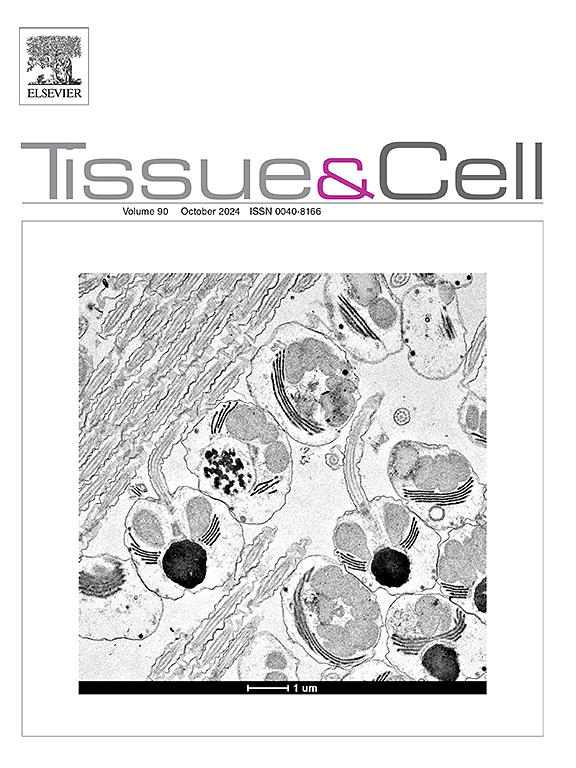Selenomethionine suppresses lung tumor growth without hepatorenal toxicity in mice via the induction of apoptosis-ferroptosis and angiogenesis inhibition
IF 2.7
4区 生物学
Q1 ANATOMY & MORPHOLOGY
引用次数: 0
Abstract
The high global mortality rate of lung cancer underscores the urgent need for novel therapeutic strategies. Selenium (Se), an essential trace element, exhibits tumor-suppressive properties across malignancies. This study systematically evaluated the antitumor efficacy of selenomethionine (SeMet) compared with that of selenocysteine (SeCys) in Lewis lung carcinoma (LLC) cells in vitro and in tumor-bearing mice in vivo. Compared with SeCys (IC50 = 45.89 μM), SeMet demonstrated superior cytotoxicity against LLC cells (IC50 = 30.19 μM) and significantly inhibited proliferation and migration by inducing apoptosis and ferroptosis. In vivo, SeMet treatment inhibited tumour growth by 50.87 % through the suppression of angiogenesis, outperforming SeCys (27.3 %). Transcriptomic analysis revealed the downregulation of proangiogenic chemokines (Cxcl1, Cxcl2, Cxcl3, Cxcl5) and the upregulation of antitumor chemokines (Cxcl9, Cxcl16) in SeMet-treated tumors. Additionally, SeMet enhanced the activity of antioxidant enzymes (T-SOD and GSH-PX) and reduced the levels of proinflammatory cytokines (IL-6 and TNF-α) without hepatorenal toxicity. These findings establish SeMet as a multifaceted therapeutic candidate for lung cancer through dual induction of apoptosis-ferroptosis and angiogenesis inhibition.
硒代蛋氨酸通过诱导细胞凋亡-铁下垂和抑制血管生成抑制小鼠肺肿瘤生长而无肝肾毒性
肺癌的高全球死亡率强调了迫切需要新的治疗策略。硒(Se)是一种必需的微量元素,在恶性肿瘤中表现出抑制肿瘤的特性。本研究系统地比较了硒代蛋氨酸(SeMet)和硒代半胱氨酸(SeCys)在Lewis肺癌(LLC)细胞和荷瘤小鼠体内的抗肿瘤作用。与SeCys (IC50 = 45.89 μM)相比,SeMet对LLC细胞(IC50 = 30.19 μM)表现出更强的细胞毒性,并通过诱导细胞凋亡和铁下垂显著抑制细胞增殖和迁移。在体内,SeMet治疗通过抑制血管生成抑制肿瘤生长50.87 %,优于SeCys(27.3 %)。转录组学分析显示,在semet治疗的肿瘤中,促血管生成趋化因子(Cxcl1、Cxcl2、Cxcl3、Cxcl5)下调,抗肿瘤趋化因子(Cxcl9、Cxcl16)上调。此外,SeMet提高抗氧化酶(T-SOD和GSH-PX)活性,降低促炎细胞因子(IL-6和TNF-α)水平,无肝肾毒性。这些发现表明,SeMet通过双重诱导凋亡-铁下垂和血管生成抑制,在肺癌治疗中具有多方面的候选作用。
本文章由计算机程序翻译,如有差异,请以英文原文为准。
求助全文
约1分钟内获得全文
求助全文
来源期刊

Tissue & cell
医学-解剖学与形态学
CiteScore
3.90
自引率
0.00%
发文量
234
期刊介绍:
Tissue and Cell is devoted to original research on the organization of cells, subcellular and extracellular components at all levels, including the grouping and interrelations of cells in tissues and organs. The journal encourages submission of ultrastructural studies that provide novel insights into structure, function and physiology of cells and tissues, in health and disease. Bioengineering and stem cells studies focused on the description of morphological and/or histological data are also welcomed.
Studies investigating the effect of compounds and/or substances on structure of cells and tissues are generally outside the scope of this journal. For consideration, studies should contain a clear rationale on the use of (a) given substance(s), have a compelling morphological and structural focus and present novel incremental findings from previous literature.
 求助内容:
求助内容: 应助结果提醒方式:
应助结果提醒方式:


